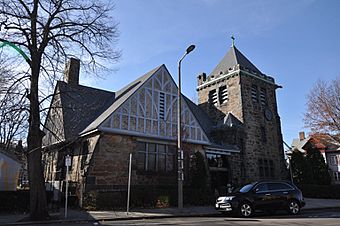Charles Street African Methodist Episcopal Church facts for kids
Quick facts for kids |
|
|
Charles Street African Methodist Episcopal Church
|
|
 |
|
| Location | Boston, Massachusetts |
|---|---|
| Built | 1888 |
| Architect | J. Williams Beal; Multiple |
| Architectural style | Tudor Revival |
| NRHP reference No. | 83000601 |
| Added to NRHP | September 1, 1983 |
The Charles Street African Methodist Episcopal Church is a historic church in Boston, Massachusetts. It is part of the African Methodist Episcopal Church (A.M.E.), one of the oldest African American church groups in the United States. The beautiful brick building you see today was built in 1888. Because of its long and important history, it was added to the National Register of Historic Places in 1983.
Contents
The Church's Long History
The story of this church is a journey through some of the most important times in American history. It started on Beacon Hill and later moved to the Roxbury neighborhood of Boston.
Starting on Beacon Hill
A small group of people, led by Reverend Noah Caldwell, started the church in 1833. At first, they met on Belknap Street, which is now called Joy Street, in a neighborhood known as Beacon Hill. By 1838, the church had only 35 members. They asked the state of Massachusetts to officially recognize them as a church. In 1839, their request was granted, and they became known as the First A.M.E. Society Church.
In 1844, the church bought its own building on Anderson Street. This building became a very important place during the years before the American Civil War. It was a center for the abolitionist movement, which worked to end slavery. Famous speakers like William Lloyd Garrison, Wendell Philips, and Frederick Douglass gave speeches there to support the anti-slavery cause.
During this time, the church faced challenges. A new law called the Fugitive Slave Law of 1850 made life harder for Black people in Boston. The church's membership went down, and it struggled with money problems. But after the Civil War ended, the church was able to pay off its debts and grow again.
Moving to Charles Street
By the 1870s, Boston's Black population was growing, and so was the church. It became the largest Black church in the city and needed more space. In 1876, the congregation bought the Charles Street Meeting House, a larger building that had belonged to a white church.
This big move was exciting, but it also put the church into debt. A powerful speaker named Rev. John T. Jennifer arrived in 1880. He was a great leader who inspired many new people to join. He also spoke about important topics like civil rights. By the time he left in 1886, the church was much stronger and had paid off most of its debt.
A New Home in Roxbury
Over time, many Black families began moving from Beacon Hill to other neighborhoods like the South End and Roxbury. The church's membership started to shrink again. In the 1920s, the city of Boston decided to make Charles Street wider, which meant the church had to move.
In 1939, the congregation moved to its current building at 551 Warren Street in Roxbury. This building was built in 1888 and was once a church for a different group. The Charles Street A.M.E. Church was the last major Black organization to leave Beacon Hill. This move showed how Boston's neighborhoods were changing. The church kept its original name to honor its history.
The Church's Architecture
The church building at 551 Warren Street is known for its unique and beautiful design.
Building and Design
The main architect for the church was J. Williams Beal, a well-known Boston architect. The building has an L-shape and is made of brick. One of its most striking features is a square tower that looks a bit like a castle, with a high, pointed roof. It even has stone carvings of gargoyles on it!
The building has beautiful gables, which are the triangular parts of the roof. Many of the original stained-glass windows are still there. These colorful windows show pictures of saints. Some windows were designed by John LaFarge, a famous American artist who also made windows for Trinity Church in Boston.
Special Features
Inside the church, there used to be a large organ made by Hook and Hastings, a famous organ builder. There was also a special lectern, or speaker's stand, carved from wood in the shape of an eagle. While these are no longer in the church, they were an important part of its past.
The outside of the building looks very much like it did when it was first built. A clock with two faces still sits in the tower, and the original bell, made in Baltimore, Maryland, is still there.
The Church Today
The Charles Street A.M.E. Church is still an active and important part of the Roxbury community. Since 1994, under the leadership of Rev. Gregory Groover, the church has grown and started many new programs to serve its members and the neighborhood. It continues to be a place of faith and a center for community life, carrying on its long and proud history.
See also
- Charles Street Meeting House, Beacon Hill (occupied by the A.M.E. congregation 1876-1939)
- National Register of Historic Places listings in southern Boston, Massachusetts



